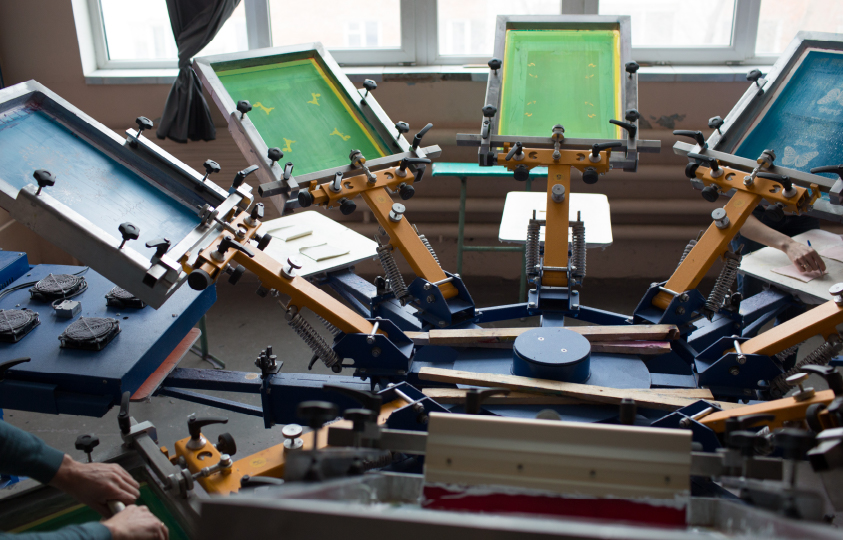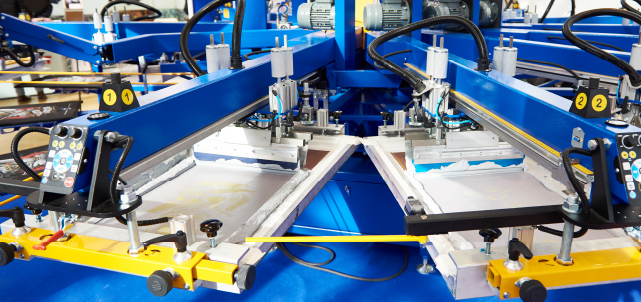Screen printing, long a cornerstone of the print industry, is evolving rapidly as new technologies and shifting market demands redefine the landscape. As we look toward 2025, a blend of traditional craftsmanship and cutting-edge innovation is creating exciting opportunities for screen printers. From advancements in pre-press processes to the integration of digital technologies, the future of screen printing promises both efficiency and creativity. In this blog, we will explore key trends that are set to shape the industry in the coming years.
1. Digital Evolution and Pre-Press Advancements
As screen printing techniques advance, pre-press processes are becoming more sophisticated and efficient. In the past, preparing a screen for printing involved a time-consuming series of steps, including creating films, coating screens, and exposing them to UV light. However, the latest computer-to-screen (CTS) technology eliminates many of these manual processes.
CTS systems allow for high-resolution imaging directly onto the screen, bypassing the need for traditional films. This not only speeds up the process but also enhances the accuracy and detail of prints. With these innovations, even complex designs can be transferred with perfect alignment and minimal distortion. Furthermore, digital pre-press systems are increasingly automated, reducing the potential for human error and improving consistency.
One of the key benefits of these pre-press advancements is the ability to produce more intricate and high-quality stencils. Whether printing fine details on textiles or producing large-scale designs on promotional products, today’s pre-press technology is allowing screen printers to achieve higher resolution prints than ever before.
2. The Integration of Digital and Traditional Methods
Digital printing technologies are increasingly being incorporated into traditional screen printing workflows, creating a hybrid model that offers the best of both worlds. For instance, garment DTF (Direct-to-Film) printing is gaining momentum, enabling vibrant, full-color designs to be printed onto a specialized film, which is then transferred onto fabric using heat. This process is particularly advantageous for producing detailed and intricate designs, handling various fabric types, and fulfilling short-run or customized orders with greater efficiency compared to traditional methods.
However, traditional screen printing still has the upper hand when it comes to larger print runs and special effects like glitter or metallic finishes. Hybrid printing solutions allow companies to combine the precision and flexibility of DTF printing for detailed designs with the durability and cost-effectiveness of screen printing for larger orders. This integration is opening up new possibilities for screen printers, particularly in the fashion and promotional industries.
Moreover, digital innovations are enabling high-resolution prints that were previously difficult to achieve with traditional screen printing methods alone. The fusion of digital and screen printing techniques is transforming the industry by offering unparalleled flexibility, cost-efficiency, and customization capabilities.
3. Sustainability and Eco-Friendly Practices
As sustainability becomes a growing concern across industries, screen printing is evolving to meet environmental challenges. Consumers and brands alike are prioritizing eco-friendly production methods, pushing manufacturers to adopt greener practices.
One major trend is the shift towards water-based inks, which are free from harmful chemicals and emit fewer volatile organic compounds (VOCs) compared to traditional plastisol inks. These water-based inks are becoming increasingly popular for printing on garments, as they not only provide a softer feel but are also safer for the environment.
Another focus of sustainability efforts in screen printing is the use of eco-friendly substrates. Recycled and biodegradable materials are being used more frequently in the production of screens and frames, reducing the industry’s carbon footprint. Additionally, energy-efficient screen printing machines are becoming standard, helping to lower electricity usage during the printing process.
Screen printers who embrace these eco-conscious practices can differentiate themselves in the marketplace, particularly among environmentally-minded consumers and brands. Sustainability is no longer just a trend; it’s a key factor in the future success of the screen printing industry.
4. Automation and AI in Screen Printing
Automation is a critical component of modern screen printing. Automatic screen printing presses are not only faster but also offer more consistent results than their manual counterparts. These machines can handle complex multi-color jobs with ease, ensuring perfect registration on each pass. This automation is especially useful for large-scale print runs, where efficiency and accuracy are paramount.
Additionally, AI-driven technology is being integrated into the printing process to optimize print quality. From automatic color matching systems to predictive maintenance features, AI is helping screen printers reduce waste, minimize downtime, and produce higher-quality prints. AI-powered color matching systems, for example, can automatically adjust ink formulations to ensure consistency across batches, saving time and reducing the need for manual adjustments. These advancements allow screen printers to deliver reliable and precise results, even when dealing with complex designs or tight deadlines.
In the future, AI could play an even bigger role in screen printing, helping printers make data-driven decisions that improve productivity and reduce costs. By analyzing production data, AI systems could predict potential machine malfunctions or suggest optimizations for faster turnaround times, making the entire screen printing process more efficient.
5. Spyder X: Revolutionizing Screen Printing Equipment
One of the most significant advancements in screen printing technology is EXILE’s Spyder X. A standout innovation in 2024, the Spyder X introduces a revolutionary drumless design, allowing screen printers to seamlessly switch between multiple screen sizes without the need for costly drum replacements. This adaptability offers immediate cost savings for businesses that previously had to purchase and maintain multiple drums.
With the Spyder X, screen printers can easily produce high-quality stencils for a variety of jobs without the downtime and complexity of traditional systems. This technology streamlines the entire screen preparation process, making it faster and more efficient, while also improving the precision and quality of prints. The Spyder X’s drumless design is a game-changer for printers looking to stay competitive in an evolving market.
6. Customization and Personalization on the Rise
As consumer preferences shift towards personalized and unique products, the screen printing industry is adapting to meet these demands. Customization is no longer just a luxury; it has become a standard expectation, particularly in the garment and promotional product industries. Screen printing offers a variety of customization options, including specialty inks, unique finishes, and intricate designs that can be tailored to individual customer needs.
The rise of on-demand printing has made it easier for businesses to offer personalized products without the need for large inventories. Digital technologies, such as DTG and hybrid solutions, complement traditional screen printing by allowing for quick turnaround times on custom orders. This is particularly advantageous in the fashion industry, where trends change rapidly, and the ability to produce limited runs of customized apparel is crucial.
Furthermore, online platforms have made it easier for consumers to design their own products, further driving the demand for customizable screen printing services. As this trend continues, screen printers that can offer personalized solutions will have a competitive edge in the market.
7. Adapting to a Digital-First Marketplace
The rise of e-commerce has changed the way screen printers do business. As more consumers shop online, print companies must adapt to the digital-first marketplace by offering seamless online ordering and customization options. Screen printers are now investing in e-commerce platforms that allow customers to browse, customize, and order printed products directly from their websites.
These platforms are not only convenient for customers but also enable printers to streamline their operations. Automated ordering systems can feed directly into production workflows, ensuring that orders are processed quickly and efficiently. Additionally, screen printers are utilizing digital marketing strategies to reach new audiences, including social media advertising, email campaigns, and search engine optimization (SEO).
As digital commerce continues to grow, screen printers that embrace these technologies will be well-positioned to capture a larger share of the market. Offering a frictionless online experience will be key to attracting and retaining customers in an increasingly competitive digital landscape.

Rely on EXILE’s Quality Screen Printing Technology
The future of screen printing is being shaped by a combination of technological innovation, sustainability efforts, and the growing demand for customization. With cutting-edge advancements like EXILE’s Spyder X, streamlined pre-press processes, and the integration of digital printing technologies, the industry is becoming more efficient, flexible, and adaptable to the needs of modern consumers.
As screen printers continue to embrace automation, AI, and eco-friendly practices, they will not only improve their production capabilities but also position themselves for long-term success. Whether it’s offering high-quality custom prints or adopting sustainable production methods, the screen printing industry is evolving to meet the challenges of tomorrow.
Looking ahead, it’s clear that screen printing will remain a vital part of the print industry, with new innovations and trends ensuring its relevance well into 2025 and beyond. For screen printers, the key to thriving in this new era will be to stay ahead of these trends and continue to innovate. Visit our website and contact EXILE today to learn more about how we can upgrade your screen printing processes.



